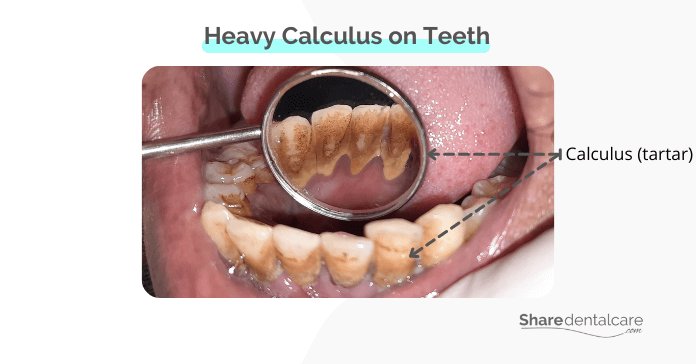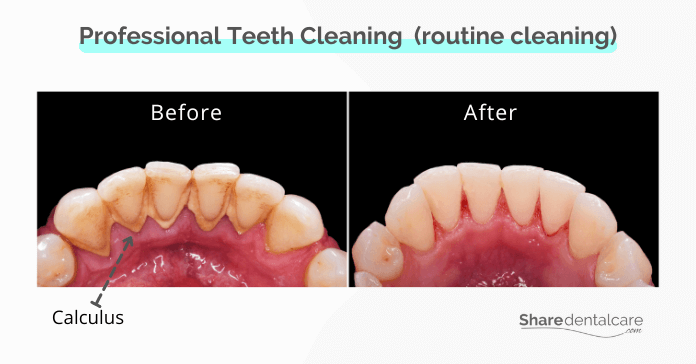Most people don’t think much about their teeth until there’s a problem. And by then, it’s often too late. Cavities, gum disease, and other dental problems can be expensive and painful to fix. One common problem is that many people don’t even realize they have heavy calculus build-up on their teeth. In this blog post, we’ll discuss what heavy calculus is, how to recognize the signs of it, and what you can do to get rid of it.
What is Calculus (Tartar)?
Calculus, also known as tartar, is a hard, yellow-to-brown deposit that forms on teeth. It is a hardened form of plaque, which is a sticky film of food debris, bacteria, and saliva that constantly forms on your teeth.
Dental plaque is usually removed through daily brushing and flossing. However, when plaque is not removed regularly, it hardens into calculus (tartar), which can only be removed by a professional dental cleaning. If the calculus is left on teeth for a long time, it becomes heavy and causes dental problems. Calculus comes in two forms:
- Supragingival calculus, which forms above the gum line. It is usually yellow or brown and can be easily seen on the teeth.
- Subgingival calculus, which forms below the gum line. It is usually darker in color and can be more difficult to see.
Both types of calculus can cause problems if they’re not removed.

Causes & Risk Factors
There are a few things that can increase your risk of developing calculus on your teeth, including:
- Poor oral hygiene: It is the most significant risk factor for heavy calculus build-up. If you don’t brush and floss your teeth regularly, plaque will have a chance to harden into calculus.
- Tobacco use: Smoking or using other tobacco products causes dry mouth, which can lead to plaque build-up. You can read more about how smoking can damage your teeth.
- Dry mouth: Saliva washes away plaque and bacteria, so a lack of saliva can lead to calculus build-up.
- Crooked teeth: Teeth that are crowded or overlap each other can be more difficult to clean, which can lead to heavy calculus build-up.
- Foods and drinks high in sugar: A diet high in sugary foods and drinks can contribute to the accumulation of plaque on teeth.
- Some medications: Certain medications, such as anticholinergics and calcium channel blockers, can decrease saliva production and increase the risk for plaque and calculus build-up. You can read more about the link between diabetes medications and teeth breaking.
If you have any of these risk factors, it’s important to practice good oral hygiene and see your dentist regularly. Heavy calculus on teeth can be a serious problem if it’s not removed.
How to Know if You Have Heavy Calculus Build-up on Your Teeth?
There are a few signs that you may have heavy calculus build-up on your teeth. If you notice any of the following, it’s time to see a dentist:
- Bad breath that doesn’t go away with brushing or mouthwash
- Yellow or brown staining on your teeth
- Red, swollen gums
- Receding gums
- Gums that bleed easily
- Sensitive teeth
If you notice any of these signs, don’t wait to see a dentist. The longer the calculus is left on your teeth, the more damage it can do to teeth and gums.
What are the Risks Associated with Heavy Calculus Build-up on Teeth?
Calculus bacteria produce toxins that can damage the gums and cause inflammation. This can lead to gingivitis, which is the early stage of gum disease. If left untreated, gingivitis can progress to periodontitis, which is a more serious form of gum disease. Periodontitis can damage the gums, bones, and other tissues that support the teeth. In severe cases, it can lead to tooth loss.
In addition to gum disease, heavy calculus build-up can also cause tooth decay. The bacteria in calculus produce acids that can eat away the tooth enamel, causing cavities. If the cavities are not treated, they can become large and cause pain. Over time, the teeth can become severely damaged and may need to be extracted.
How the Calculus is Removed?
Calculus can’t be removed with brushing or flossing. It can only be removed by:
- Professional teeth cleaning (routine cleaning)
- Scaling and root planning (deep cleaning)
During professional teeth cleaning, the dentist or hygienist will use special instruments (periodontal scalers) to scrape the calculus off of the teeth. The teeth will then be polished to remove any remaining calculus and to make them look shiny and smooth. Professional teeth cleaning is usually done every six months.
If you have heavy calculus build-up on your teeth, the dentist may recommend scaling and root planning. This is a deep cleaning that is done under local anesthesia. Scaling involves using special instruments to remove the calculus from above and below the gum line. Root planning involves smoothing out the roots of the teeth to remove any bacteria that may be present. Scaling and root planning are usually done in two or three sessions.

How to Prevent the Build-up of Heavy Calculus on Teeth?
The best way to prevent heavy calculus build-up on teeth is to practice good oral hygiene, including:
- Brush your teeth twice a day with a toothbrush that has soft bristles.
- Floss your teeth at least once a day.
- Use an antibacterial mouthwash.
- See your dentist regularly (every 6 months) for professional cleanings and checkups.
- Limit sugary foods and drinks.
- Quit smoking.
If you have heavy calculus build-up on your teeth, it’s important to get it removed as soon as possible. The longer it’s left on, the more damage it can do to your teeth and gums.
Heavy Calculus on Teeth – Conclusion
Calculus, also known as tartar, is a hard, yellow-to-brown deposit that forms on teeth. It forms when plaque, a sticky film of bacteria, hardens on your teeth. Calculus can only be removed by a professional cleaning. If not removed, it can lead to gum disease, tooth decay, and even tooth loss.
Calculus usually occurs as a result of poor oral hygiene. So, the best way to prevent it is to practice good oral hygiene, including brushing, flossing, and using an antibacterial mouthwash. You should also see your dentist regularly for professional dental cleaning and checkups.